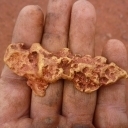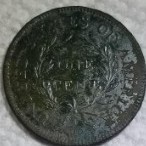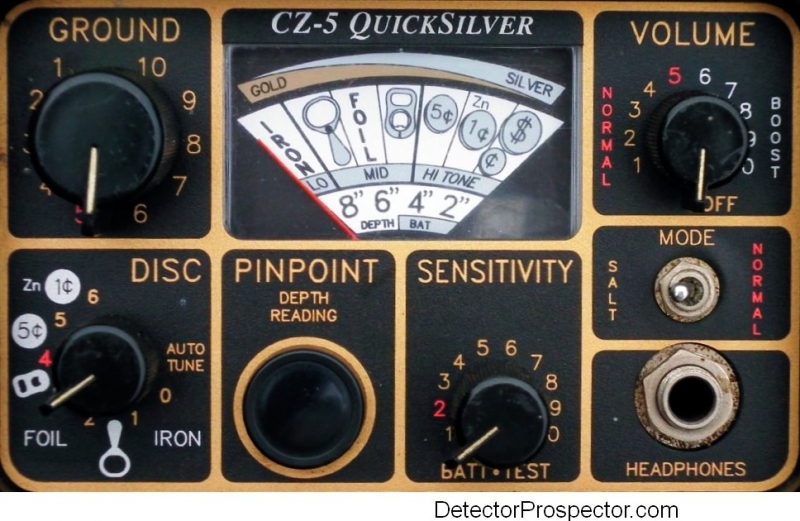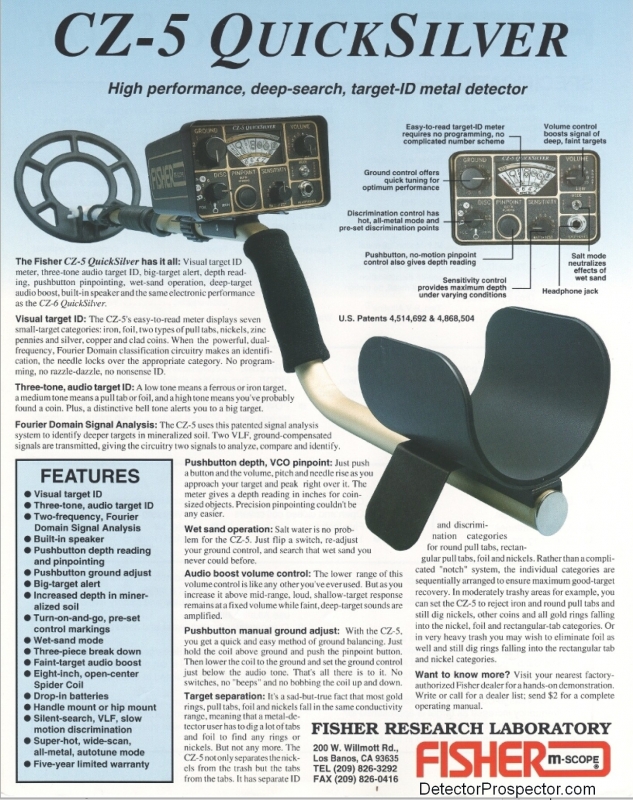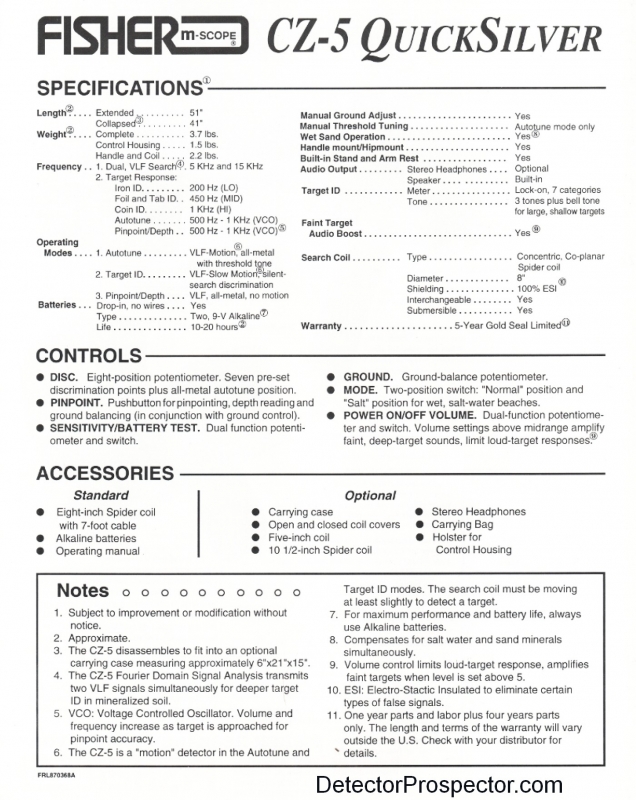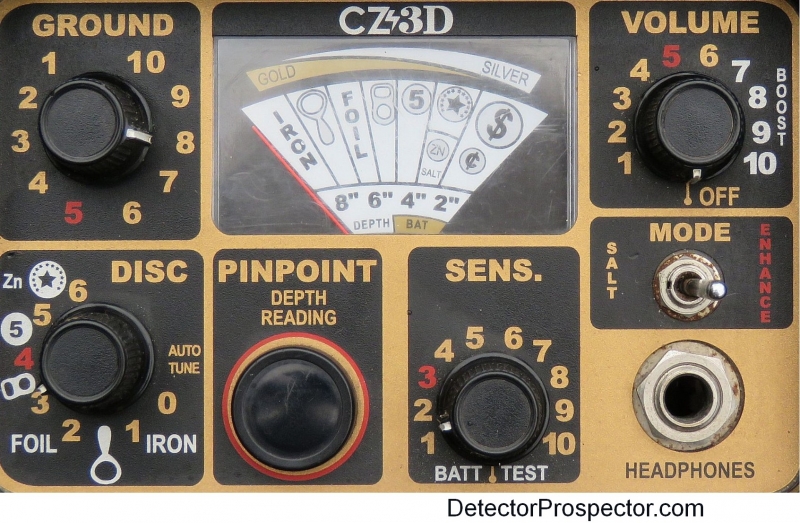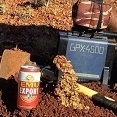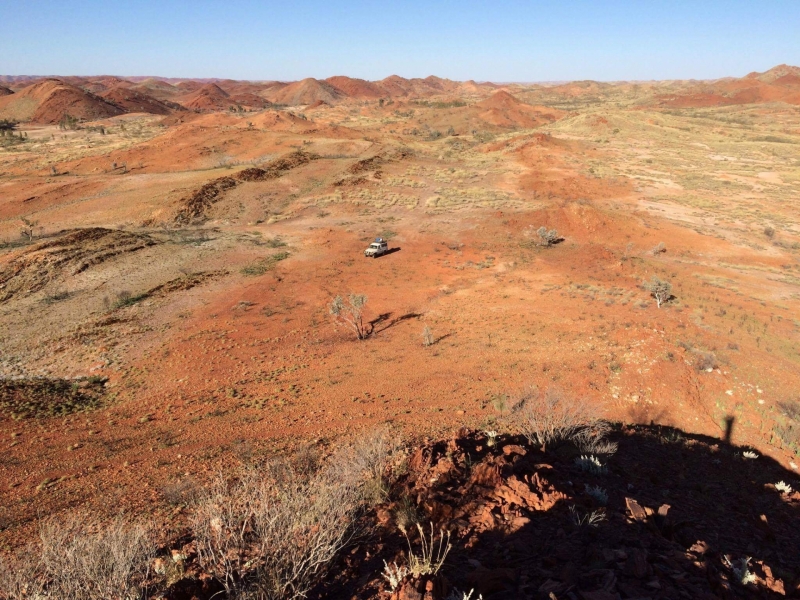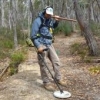Leaderboard
Popular Content
Showing content with the highest reputation on 08/22/2017 in all areas
-
21grs from about 5kg of rock sample with no signals or visible gold, hope the rest is like this5 points
-
A California woman says she found a 1½ carat diamond while mining gold near the Sierra Nevada foothills town of Foresthill. “I was like ‘Oh, my god, I found a diamond,’ ” said Jillian Kelly. Kelly, 49, left her Silicon Valley career to take up mining 10 years ago and wrote ‘The Miracle Miner: My Life as a Female Gold Miner.” The uncut semi-clear pebble-sized stone is about width of a dainty pinky finger. The rest of the story with photos at The Sacramento Bee1 point
-
1 point
-
Balance with the 10.5" coil is sub-par. I never had an 8" for mine, but used the 5 and 10.5. I made up a sling/chest mount for my control box, but should have put some weight on mine behind the cuff to make it better to swing....my shoulder is a bit damaged by swinging it. I should have spent more effort making it more ergonomic and kept it...it did rock on the wet sand in NJ, and found me quite a few deep old coins inland as well.1 point
-
So far only Fisher, Minelab, and White's have dabbled in multifrequency in any real way. Fisher and Minelab both introduced their new multifrequency designs in 1991 and so both can argue the fine details of who was "first". 1991 Fisher CZ-6 5 & 15 kHz 1991 Minelab Sovereign BBS 1999 Minelab Explorer S/XS FBS 2001 White's DFX 3 kHz or 15 kHz or both at once 2009 White's Spectra Vision 2.5 Khz or 7.5 kHz or 22.5 kHz or all three at once 2012 Minelab CTX 3030 FBS2 The CZ series was developed by Fisher Research with lead engineer Dave Johnson playing a major part. Running at 5 kHz and 15 kHz, the CZ is still one of the better coin detectors ever made and is particularly effective in saltwater environments. The CZ-20/CZ-21 is still considered to be one of the best saltwater models made. The basic CZ design is the same with the exception of the still in production CZ-3D, which tweaked and moved various target responses in an attempt to deliver more and better old coin finds. The CZ series is an old analog design requiring a great deal of hand tuning. This tuning suffered greatly as the "old" Fisher at Los Banos went out of business and took time for the "new" El Paso Fisher to get right. Details here by Dave J. I had several CZ detectors and my personal favorite was the CZ-5. The CZ series will chase coins with the best detectors made today. The only real complaint you will hear is a tendency to identify some deep nails as non-ferrous coin targets. The Cz series is quite unique because Fisher rearranged the classic target id scale. Nickels in particular were placed at the high end along with the rest of the coins. The scale is very basic - iron (low tone) aluminum (med tone) and coins (high tone). This simple systems is very effective in practice for coin detecting; just go dig high tones. It was so effective the CZ was nicknamed the "Coin Zapper". A fourth tone was added later to break the zinc penny/indian head penny range out as a separate "old coin" range. Fisher CZ Approximate Release Dates CZ-6 Quicksilver 1992 CZ-6a Quicksilver 1992 CZ-5 Quicksilver 1993 CZ-20 ( Underwater ) 1995 CZ-7 Quicksilver 1997 CZ-7a 1998 CZ-7a Pro Quicksilver 1999 CZ-70 Pro Quicksilver 2003 CZ-3D 2004 CZ-21 ( Underwater ) 2009 I often toy with getting another CZ but I never end up being happy playing the nostalgia game. It was always my wish that Fisher somehow reproduce the CZ as a compact digital design but so far it has never happened. The closest you get is the single frequency F75 which can be set up to emulate the CZ tones to a large degree. Making a direct translation from analog to digital apparently is not easy without something getting lost in translation. The Fisher CZ-3D is still in production. Information here. For information on changes made in the CZ-3D see Fisher Intelligence, page 5 - CREATING THE CZ-3D FOR THE REAL WORLD Fisher CZ-5 and Fisher CZ-3D Control Panels Compared (Click on all following images for larger views):1 point
-
Dang Steve, you've probably already tested this machine... tell us about it grin.1 point
-
Hi Robbie and welcome to the forum. Big coil for deeper/larger targets and small coil for smaller/shallower targets. I've been using mine quite a bit lately when I can get out for an hour or two. Mostly trying to hit trash infested spots and utilize the discrimination which is essentially why I bought this machine. Are you expecting too much from it? Well, my answer is that the HM will find small gold and it will also find larger, deeper gold IF IT IS THERE. And I think that is the key - the gold has to be there first. I have dug about 30cm for a really large bullet projectile (unsure of caliber) and about 50 centimeters for a large bit of pipe (showing as non-ferrous). So I don't think you are expecting too much of the GM but maybe too much of the goldfields - the yellow stuff is pretty sparse. Is it the bees knees for beginners? Well, it is easy to use, there aren't many settings but there are still some things you can tweek for the location you are detecting. Also, considering you are in quite mineralized ground (Australia) a VLF may be a bit trickier to use than in the US, NZ, Africa, etc. Personally, I think the bees knees for a beginner is the SDC. It is very, very forgiving in hot ground, extremely sensitive, basic to use, waterproof, has reasonable depth, lightish, good battery life, compact, etc, etc, etc. You mentioned the GPX. The GPZ, SDC and GM I have or do own, a GPX I have not so it is a bit hard to comment and someone can correct me if I am wrong. The one thing that I am told constantly is that the GPX series has a mirriad of setting combinations and has a really long, steep learning curve. And then add in the tens of coils that you can utilize and the choice just gets mind boggling. To my mind it is not a beginners machine unless you have the time, understanding and patience to really get the best out of it. For those that can do this the GPX series is super versatile. I hope that helps and doesn't confuse you more Edit: and what minesweeper and orphirboy said above1 point
-
Don't give up and loose faith, Detecting of any type is a life long process and we never stop learning, As for the depth you are seeing in your tests that will change out in the real world sometimes it will be deeper sometimes it will be shallower, No 2 Nuggets are the same and depending on their shape/thickness 2 identical weight nuggets can and will be picked up at different depths, ground conditions will play a major part in this also, At what the GM can do it is the Bees Knees, but you can not go comparing it to a GPX, The GPX has got lousy discrimination and is a very deep machine with the sole purpose of finding Gold in highly mineralized ground. Your GM can tell whether a signal is junk/Iron or Gold, Copper Lead or some other Alloy, and In old mining sites it is perfect for sifting through the junk that miners left behind pulling out nuggets that they either threw away or missed, All people should try to use a VLF/LF machine first and I am not talking about when they first start detecting, I include all prospector/detectorists, If a person can get their VLF (LF) to work in their sites then that is a good thing because it will save them time in digging less junk, There is a fashion in Australia where most seem to be convinced that you have to have a PI machine when this is only partly true, A person should check the ground out with a VLF first and if needed then switch to a PI machine. PI's have become more of a crutch where people swear black was blue that a VLF is useless out there when it is not true, 99% of them wouldn't even know because they haven't even tried one there so how do they know ?. Before the birth of the PI all people had was VLF's and they did quite well with them also, Take a PI in to an old mining area and I guarantee that you will be feeling very let down within the first 2 hours of digging junk where "Your" GM will run rings around them, What I am saying is there is a right and a wrong time to use a GPX/TDI or what ever other machine you want to add and there is a right and wrong time to use a VLF. The Smart prospector will own both and have them both at hand when the need arises, In my years of detecting by picking the right machine for the task at hand I have yet to be skunked no doubt it will happen, But if one machine is not working for me I swap machines and if that don't work then I change coils etc, Any one can learn how to run a machine but learning the skills as in what machine/coils to deploy to suit the current conditions makes a huge difference, Classic example is try running a GPX with a thunder storm within 200 miles of your location and as good as the GPX is they don't like storms yet the TDI SL can be maxed out in such conditions, The GPX series are the best PI's but junk and storms will drive them nutz, Have a good read of Steve's Guide to Nugget Detectors, and you will see that he owns a few that he can adapt to his current conditions and locations, the wise prospector would do likewise, and when you can afford a GPX I would hang on to your GM-1000 so you can adapt to your locations also, hope that helps, https://www.detectorprospector.com/magazine/steves-guides/steve-guide-gold-nugget-detectors/ John.1 point
-
I still don't see why all the fuss about a machine that is "not" designed for extreme conditions, I can understand people taking there to see how it does but there is no point in complaining about it when it behaves just as they thought it would all along, when a lower KHz machine might be the better option with a hotter Coil If a VLF has to be used, I can understand taking it along as and when it is needed if the ground is full of junk but in hot soil conditions I would be more concerned about how the GPX or SDC would run. A VLF/LF will run there but at a reduced Gain setting so depth will be lost and sensitivity to small gold will be out the window and the only way to regain some of those losses is to use a very small concentric or DD coil , This is detecting 101 and the type of stuff people learn in their first year of the hobby, Seasoned prospectors should not be making such a mistake. John.1 point
-
Yep.. wind here would rip your mum clean off the dunny! just finished the next one, not quite as good but not complaining1 point
-
Hi John, always like to see how prospectors are preparing for remote trips. I take my troopy off track a lot and weight is always an issue as I go places where you cannot have any trailer attached. With Jacking I use two bottle jacks and a block of wood. My back up is a airbag jack (with a thick piece or tarpaulin to protect it). I have used it a lot in soft ground bogged situations. For the benefit of anyone who is buying a tyre plug kit...they must be very solid steel like the one you have pictured. Spare reaming and plug insert needles are a must in case they bend/break. Steer away from the cheapies with plastic hand grips, on a 4wd tyre the needles can actually break through the plastic and drive trough the palm of your hand as you try press the plugs in. PS. I have seen many friends and prospectors outback with up to 8 plugs in their tyres...no worries. (although not recommended when you get back on the tar...keep speeds low). Best of luck on your adventure. RDD1 point
-
Hi all, While up in the goldfields earlier this week I tried the Impact on a trashy spot. I used the stock 11x7" coil in the All-metal Gen mode and 20 kHz. I was very impressed at how well it ran. I was in "warmish" mineralisation. Mild sandy wash, but with various sized hot rocks. It was where a forest track cuts across a creek/gully. This particular junction has quite a bit of trash, so I just detected along ignoring any very low numbers. Most targets dug were non-ferrous. I got fooled on one large bit of wire that was sitting upright. I dug about 4 hot rocks that were a very faint but good sounding signal, but not strong enough to register any ID on the screen. The most impressive dig was a nice clear hit ID of 35, and I dug down and it was a small round seal off a juice bottle, which was sitting on it's edge. No gold, but Zed's have cleaned up all the fainter signals in this spot so no surprises there. My settings were Sens 66-72 and iSat on 6. I wasn't using Tracking, so was re-ground balancing using the trigger. I've done some tests using the smaller 7.5" elliptical in 20 kHz, against the Fors Gold+ (19 kHz) with the 5" coil, and there really isn't much in it. The Gold+ has a little bit more aggressive sound to it, but the Impact is smoother, sounds pretty much like an older wiser Gold Racer The threshold and tone adjustments steps in the Impact are spot on - two features I rate very highly for a unit to be taken seriously as a gold machine. It's really looking to be an excellent all-rounder.1 point
-
I wish Nokta had spread the frequency more. Like 5 - 14 - 30 kHz. The Nokta/Makro units already run really hot and so there is not much difference going from 14 to 20 kHz. I expect the Impact to be an extremely capable gold detector for a VLF but at the end of the day I offer the same criticism with it that I have in other multi purpose machines. And that is that machines like a DEUS or Impact are first and foremost for people who really are looking to own one detector to do multiple things with the emphasis being on coin, relic, and jewelry. If all a person wants is a VLF purely to go prospecting, then I think machines made as dedicated prospecting units are the better way to go. Thats not to say you give anything up going to something like the Impact. Not at all. Just the opposite in fact and what you get is a ton of features at a higher price. It's just that most of those extra features will go unused by the average prospector yet you pay for them. To me the real promise in a machine like the Impact is that you have extra ground handling by way of frequency that a single frequency machine lacks. So in theory a person can be running at 20 kHz and doing well. Then that person runs into some bad hot rocks that really light up at 20 kHz. In theory dropping back to 5 kHz should really help smooth things out and allow the machine to punch much deeper in bad ground on larger gold, especially if the large 15" coil was used. So the way I would tend to look at the Impact is as a great machine for a person wanting to hunt large gold in bad ground running the large coil, and still have a small gold sniper running a smaller coil at 20 kHz. At some point I will round up the large coil and sort all of this out but I am in no rush so you may beat me to it Nenad. I am in particular interested in how the Impact with 15" coil at different frequencies stacks up against the Gold Racer with 15" coil. Thanks for the report!1 point

